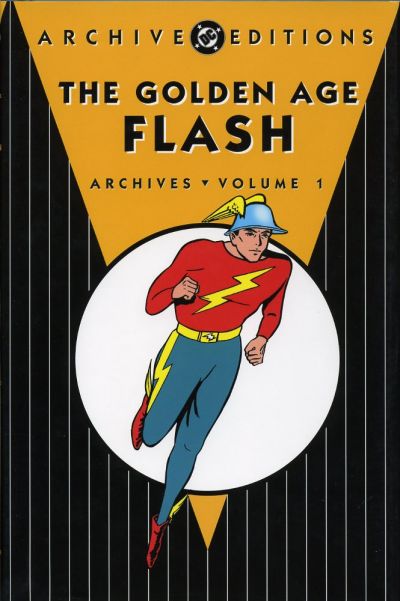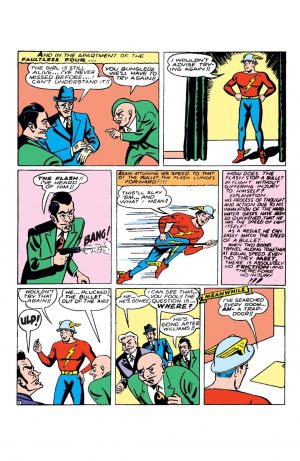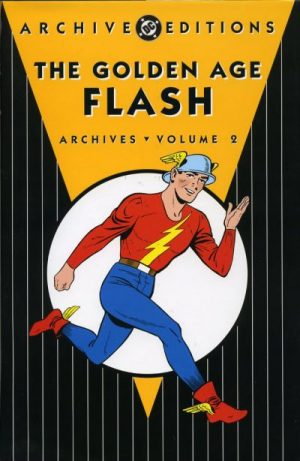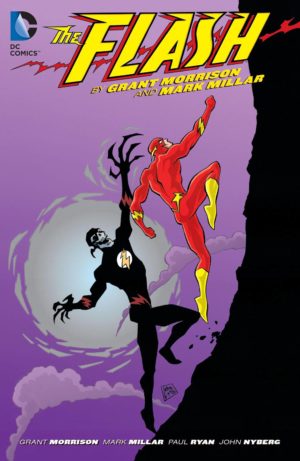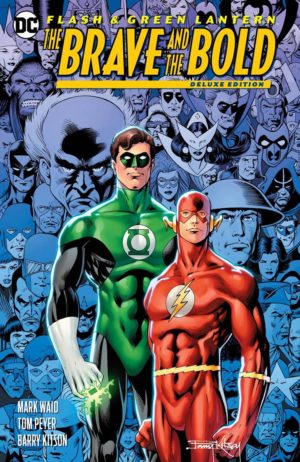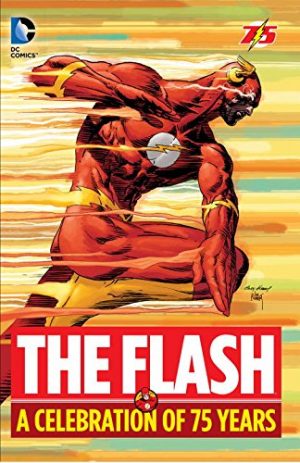Review by Win Wiacek
The innovative fledgling company that became DC published the first ever comic super-speedster. Devised, created and written by Gardner Fox and initially visually realised by Harry Lampert, in 1940 Jay Garrick quickly became a veritable sensation.
His invention as a strictly single-power superhero created a new trend in the burgeoning action-adventure comic marketplace, and this charmingly beguiling deluxe edition collects seventeen of the irrepressible Garrick’s whimsically eccentric exploits in (regrettably untitled) adventures. This first eighteen months of tales has an appealing rawness, light-hearted whimsy and scads of narrative experimentation, featuring a brilliant nerd and (ostensibly) physical sad-sack who became a social reformer and justice-dispensing human meteor.
‘The Fastest Man Alive’ speedily delivers an origin and returning cast in fifteen pages, and stages a classic confrontation with a sinister cabal of gangsters. It all started years previously when student Garrick passed out in the lab at Midwestern University, only to awaken hyper-charged and the fastest creature on Earth thanks to the “hard water fumes” he had inhaled whilst unconscious. After weeks recovering in hospital, the formerly frail chemist realised the exposure had given him super-speed and endurance. He promptly sought to impress his sort-of girlfriend Joan Williams by becoming an unstoppable football player.
Time passed, the kids graduated and Garrick moved to New York where, appalled by rampant crime, he decided to do something about it. The Flash operates mostly in secret until one day, whilst idly playing tennis with himself, Jay meets Joan again, just as mobsters try to kill her in a drive-by shooting.
In his second appearance the Flash stumbles upon a showgirl’s murder and discovers that Yankee mobster Boss Goll and British aristocrat Lord Donelin plan to take over the entire entertainment industry with ruthless strong-arm tactics. The speedster is as much hindered as helped by wilful, “headstrong” Joan who begins her own lifetime obsession of pesky do-gooding here.
Artist Everett E. Hibbard began a decade-long association with Flash’s third appearance, when Major Williams’ Atomic Bombarder is targeted by foreign spies. The elderly boffin framed for treason prompts Garrick to come to his future father-in-law’s aid, before Jay and Joan smash an off-shore gambling ring graduating to kidnapping and blackmail.
During these early adventures, Flash seldom donned his red, blue and yellow outfit, usually operating invisibly or undercover to play super-speed pranks with merciless, puckish glee, and paying scant attention to preserving any kind of secret identity. That changes when Joan is kidnapped by Mexican mobsters aware of her connection to the Flash.
Over his first eight outings the Flash foils a parade of gangsters, corrupt contractors and corrupt politicians. Fox, though, gradually became more imaginative, and before Flash’s first year is out he’s faced a brigade of giant Gila Monsters, and The Chief, whose sinister brilliance enables him to devise stroboscopic glasses to track and target the invisibly fast crime-crusher. With the threat of involvement in the “European War” a constant subject of American headlines, the heroic human hurricane intervenes to save tiny Ruritanian nation Kurtavia from ruthless invasion. Garrick sinks submarines, repels land armies and crushes airborne blitzkriegs for a fairy tale happy ending.
Hal Sharp begins illustrating toward the end, with Hibbard assigned to the forthcoming All-Flash Quarterly– to be seen in Volume 2.
This collection is a sheer delight for lovers of the early fights ‘n’ tights genre: exuberant, exciting and funny, although certainly not to every modern fan’s taste. Of course, with such straightforward thrills on show any reader with an open mind could find his opinion changed in a flash!
